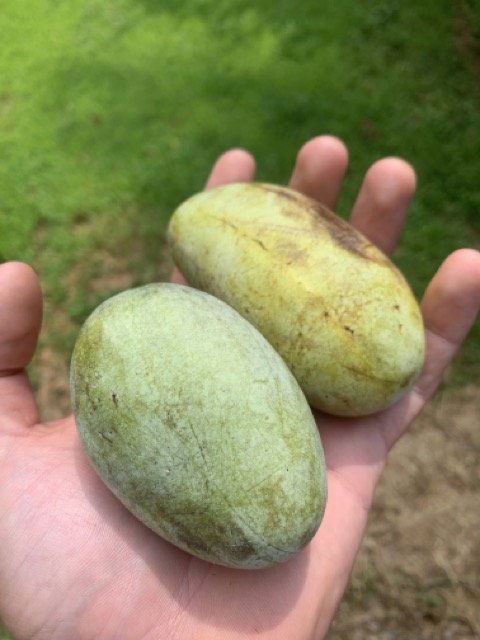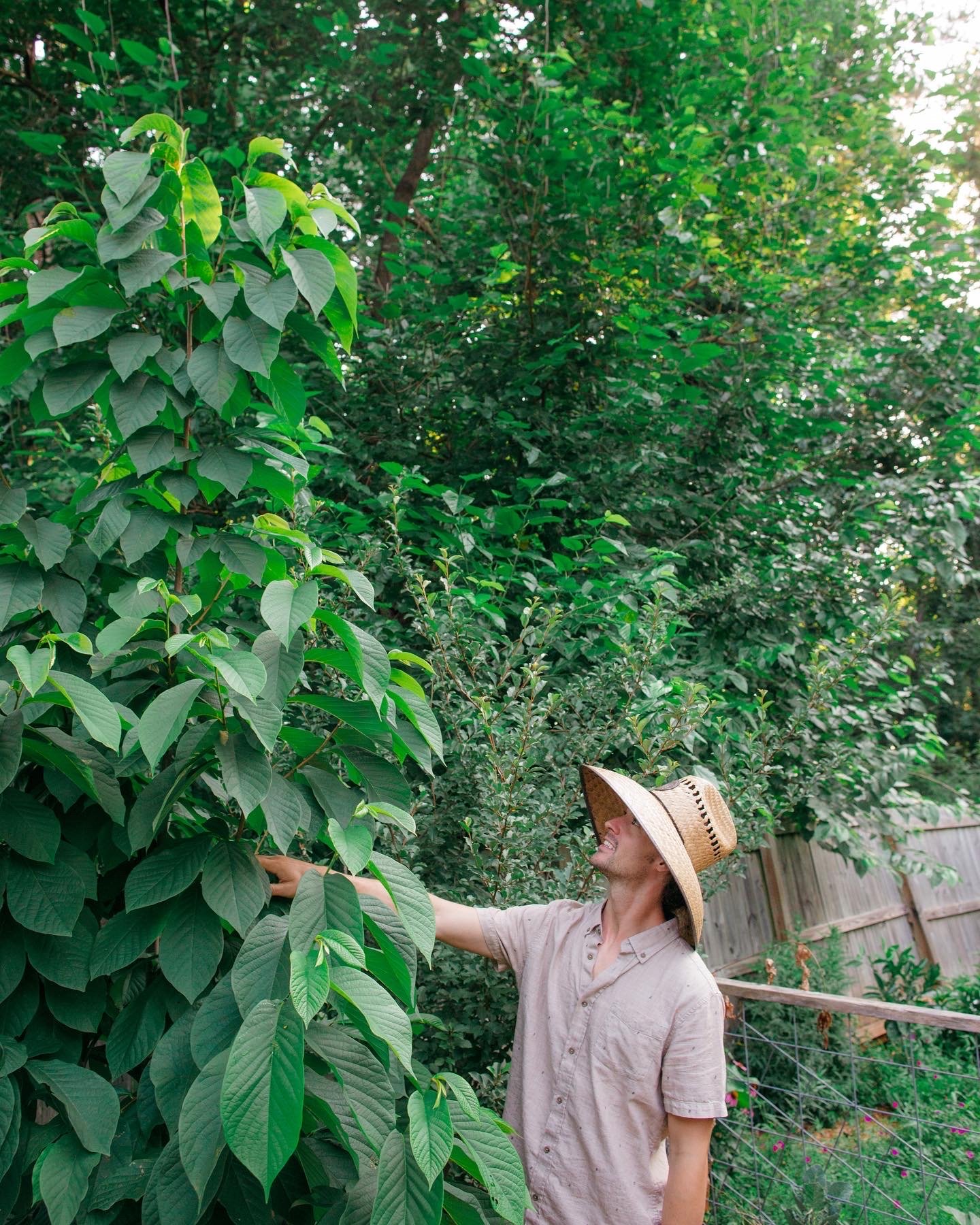Pawpaw Trees & Fruit: Everything You Would Ever Want to know About this Native Georgian Fruit!
Why the Pawpaw? Not only is the pawpaw one of just a few fruit trees native to North America, it is also one of the most tropical looking (and tasting!) trees that you can grow in your snackyard. We love Pawpaws and recently invested in obtaining over 100 specialty trees for the upcoming growing season to plant at our installs and offer at our Snackyard Sale. After this article, we hope you will be as excited as we are about this amazing tree!
So why have you never heard of a Pawpaw? It is the largest native fruit that grows throughout forests from Georgia all the way up to Ohio. Yet, due to its tenuous nature (discussed below), the fruit is difficult to commercialize into an industrialized food system. As native trees, these plants were predominantly stewarded by indigenous peoples throughout the Eastern Coast. With the displacement of so many tribes throughout the East, it is very likely that this stewardship dramatically decreased. However, with a rise in local food movements, there is a re-popularization of the pawpaw, with more and more attention, research, and care being spent on this special tree.
When you’re on a hike in the woods, it is likely that you have actually walked by many pawpaw trees. You don’t have to be in an old growth forest either, they are common in backyards, urban pocket forests, and parks. One way I like to identify them is through the leaves. But not by sight, instead by smell! If you crush a Pawpaw leaf in your hand, it will smell exactly like green peppers!
Even though these trees are fairly prevalent, getting them to fruit can be trickier. For starters, while the tree loves the shade in its early years of growth, it typically wants more sunshine as it matures. Therefore, you either have to plant an older tree in your yard, or find a spot that only shades the tree to about 4-5ft.
In the wild, this dynamic is often created on a streambank, where a young Pawpaw sapling can be shaded by the forest, and as it gets older, it leans out towards the stream where there is less overstory coverage, receiving more sunlight. Naturally, the fruit then drops into the water, so you have to access it by boat to forage (highly recommend canoe foraging!).
The deep burgundy flowers open early in the Spring. For whatever reason, bees do not really pollinate the small flowers. And instead, the fruit relies on flies and certain types of beetles to pollinate. As such, the flowers are said to smell like rotting meat, but I have not yet experienced that. To attract flies, some growers will even hang roadkill on the branches! We do not necessarily recommend that route. Instead, it can be worth trying out hand pollinating.
To hand pollinate a Pawpaw, you will need a paintbrush and bowl to get started. Find the flowers that are open with pollen covered anthers. These are the male flowers. Use the paintbrush to brush the dust-like pollen into the bowl. Then you need to find the female flowers which will have a more rounded bulbous stigma in the middle of the bloom instead. Paint the pollen onto the stigma. You will need to use the pollen immediately, so make sure there are open female flowers before you get started!
Fruit: If you’ve never been lucky enough to taste the fruit, imagine a custard-like texture, similar to that of a very ripe avocado, with a flavor like a cross between a banana and mango. They are delicious straight up, but are wonderful made into sauces, smoothies, chest pies and more. Part of the reason these fruits are so rare to find is that they do not ripen off the tree, so you have to pick them at the right time. From there, they only last a few days before going bad. So you need to eat or process them fairly quickly. This makes it very difficult to commercialize the fruit. However, there is potential in selling the fruit as frozen purees or processed into preserves.
In the Edible Landscape: Due to its broad leaves and yellow fall foliage, the pawpaw is a great tree to use as a focal point in the landscape. You will need two or more to achieve proper pollination. It can also be an excellent mid-level canopy layer in a food forest setting, or planted in groups as a background planting. It is also one of the best fruit trees to grow in shady areas, but like all fruit, the more sun it receives, the more fruit it will produce.
In a few years, expect your Pawpaw trees to double in number, as they love to often send out new shoots to form small colonies. You can easily cut these back or attend to dig them up and transplant them elsewhere. What’s especially great about pawpaws is that they are fairly resistant to deer. At a client’s garden that regularly gets ravaged by deer, the pawpaws are the only plant left untouched (unless the deer accidentally snap a branch).
Conditions: Pawpaws are tolerable of a variety of soil conditions, but will prefer a fairly neutral PH, rich in organic matter and well-draining soil. As their typical native habitat by the water suggests, they do like a more moist setting, so they can be great in low-lying areas or near rain gardens. During its first year or two, it will definitely want to be regularly watered as it established its long taproot. Plant your Pawpaws about 10ft from each other and no more than 30ft from each other, to support pollination. They reach about 20ft high but stay fairly narrow. The more sun they receive, the higher the fruit production will be.In the Spring, Pawpaw leaves are one of the last to emerge, so do not panic when they still look like sticks.
For our upcoming Snackyard Sale, we have sourced these extremely hard to find named pawpaw varieties bread to the the most luscious best tasting pawpaws on the market. These Pawpaw varieties have been bred in West Virginia to increase size, flesh to seed ratio, fruit quantity and fruit flavor. Read more below about which varieties we’ll have in store! (Note the local indigenous river names of each variety)
Shenandoah pawpaw:
Good Yields
Sweet mild flavor
Fleshy – only 6% seed
Succulent, custardy texture
Most popular at DC farmers market
Responds well to pruning
Potomac pawpaw:
Extremely fleshy. Percent seed ~ 4% by weight.
Flavor sweet and rich. Texture firm, melting, smooth. Flesh color medium yellow.
Fruit size typically 12+ oz. Medium productivity.
Strong apical dominance – ie, the tree grows very upright, is less spreading than most.
The overall fruit quality on this variety is impressive.
Dr. Pomper (KSU) insisted I release this.
Susquehanna pawpaw:
Very fleshy – only 3% seed
Very sweet, rich flavor
Firm, buttery texture
Fruit size very large
Moderate yields
Responds well to pruning
Cooking with Pawpaws
While we often find ourselves eating them straight after we have harvested them, several folks out there have thought up plenty of delicious ways to serve pawpaws up:
Check out this delicious pawpaw bread from All Recipes.
The Revivalist has even been publishing Pawpaw Cocktails since 2015. YUM!
Hillsborough Homestead has compiled a full list of Pawpaw Recipes to choose from.
Drooling over there yet? Interested in growing pawpaws but not sure where makes the most sense in your yard? Contact us to set up a consultation, where we will do a site assessment, make recommendations, offer ideas for companion plants and food forest communities, and answer any questions. We are available for design and installation services as well.
Pawpaws are even becoming a bit of a celebrity in the news - check out this wonderful article from Savannah Morning News: https://daily.jstor.org/plant-of-the-month-the-pawpaw/
Sign up for the waitlist for our pawaws so you’ll be notified when they are available to purchase!





